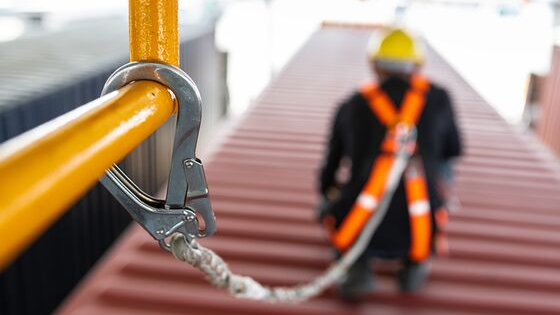No one wants to think about that feeling. You’re on stable ground until, suddenly, you’re not. The world is whipping by and gravity is having its way with you.
The construction industry has the highest risk of falls (in fact, it’s one of construction’s Fatal Four), but the truth is, falls are a serious hazard in any industry. They’re also expensive—they cost the U.S. economy approximately $70 billion each year in disability claims, medical expenses, and lost productivity.
But fall safety isn’t just an economic cost. It’s a responsibility to your workers. Here’s why you should be paying attention to it and what you can do to protect your workforce.
Why Is Fall Safety Important?
Fall incidents—often classified under slips, trips, and falls—often result from any of the following:
- Unprotected edges
- Slippery, unstable, or cluttered walk spaces
- Floor holes
- Wall openings
- Unsafe use and positioning of ladders
- Misused fall protection
Unfortunately, falls are among the most common causes of serious work-related injuries. When you think about it, that’s a bit absurd.
Fall injuries aren’t inevitable. Quite the opposite. They can be prevented quite easily—if you plan ahead, if you plan to get the job done safely, if you prioritize worker protection, if you invest in the right personal protective equipment (PPE) and training.
Keep in mind that a fall injury doesn’t just affect the victim. It affects your entire workforce. They’re less likely to feel safe if they know a friend and colleague was hurt, and they’re less likely to trust you if they know such an accident could have been prevented.
Your Responsibility as an Employer
Furthermore, it’s your legal responsibility as an employer to take preventative measures and develop safety awareness strategies.
Take the construction industry, for example. Under OSHA guidelines, employers are legally responsible for determining whether a workspace is safe and providing the appropriate fall protection when necessary.
Of course, that responsibility is not limited to construction.
OSHA also has extensive guidelines for various industries, addressing common fall issues such as ladders, staircases, powered platforms, elevators, escalators, and working surfaces.
Things to Consider Before Implementing a Fall Prevention System
When you’re considering a fall arrest system, there are a few things you’ll need to keep in mind.
First, you have to investigate whether you need fall protection. OSHA enforces the following guidelines:
Construction is required to provide fall protection at 6 feet, shipyards at 5 feet, longshoring at 8 feet, and 4 feet in the general industry. However, you are required to provide fall protection at any height when working above dangerous machinery.
Second, you need to determine whether your priority is eliminating the fall hazard or preventing it. Your workers will be safest if you can eliminate the hazard completely, but there are situations where elimination simply isn’t an option.
From there, you need to look into the appropriate fall protection measures, such as personal fall protection equipment, fall restraint systems, guardrails, scaffolds, handrails, and barriers.
You also need to ensure that your employees are trained in the correct use of these safety measures, and conduct regular audits to ensure that employees are using them properly.
Workplace Safety and Fall Protection
Slips and falls are common injuries that occur in the workplace. To ensure that work environments are safe for all employees, organizations should include fall protection in their environmental, health and safety initiatives.
Fall protection safety equipment may be as simple as a yellow strap near the end of a ladder, or a red strap at the top, which helps stabilize a straight or extendable ladder when used against a pole or other vertical surface. Other equipment includes self-retracting life lines, a safety harness and other personal equipment which a worker can attach to their bodies to prevent falls.
Fall protection also includes more elaborate equipment such as installed systems—guard rails, anchors, tether tracks, rigid rails, portable fall protection structures and of course an assortment of temporary safety and access structures.
These might include rails, ramps and other walkways constructed to enable a worker to pass safely from one area of work to another, rather than walking over or around parts being built.
OSHA recommends that employers and site foreman ensure that every floor hole—which could be unintentionally walked into—is guarded using a railing and toe board or floor hole cover. Additionally, it recommends that a guard rail and toe board are installed around every elevated, open side platform, regardless of height. Safety nets, stair railings and hand railings are other suggestions in keeping people safe on the job.
Taking Charge of Fall Safety
Fall safety is mostly a matter of preparation. You know what fall prevention requires—you just need to do your homework and implement it strategically.
We know the challenges that you face in keeping your workers safe. That’s why we develop safety tools and resources that can adapt alongside you. For more workplace safety tips and best practices, visit the EHS Insight Blog.
